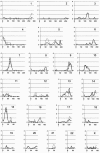A whole-genome scan in 164 Dutch sib pairs with attention-deficit/hyperactivity disorder: suggestive evidence for linkage on chromosomes 7p and 15q
- PMID: 12679898
- PMCID: PMC1180276
- DOI: 10.1086/375143
A whole-genome scan in 164 Dutch sib pairs with attention-deficit/hyperactivity disorder: suggestive evidence for linkage on chromosomes 7p and 15q
Abstract
A genome scan was performed on 164 Dutch affected sib pairs (ASPs) with attention-deficit/hyperactivity disorder (ADHD). All subjects were white and of Dutch descent and were phenotyped according to criteria set out in the Diagnostic and Statistical Manual Of Mental Disorders, 4th edition. Initially, a narrow phenotype was defined, in which all the sib pairs met the full ADHD criteria (117 ASPs). In a broad phenotype, additional sib pairs were included, in which one child had an autistic-spectrum disorder but also met the full ADHD criteria (164 ASPs). A set of 402 polymorphic microsatellite markers with an average intermarker distance of 10 cM was genotyped and analyzed using the Mapmaker/sibs program. Regions with multipoint maximum likelihood scores (MLSs) >1.5 in both phenotypes were fine mapped with additional markers. This genome scan indicated several regions of interest, two of which showed suggestive evidence for linkage. The most promising chromosome region was located at 15q, with an MLS of 3.54 under the broad phenotype definition. This region was previously implicated in reading disability and autism. In addition, MLSs of 3.04 and 2.05 were found for chromosome regions 7p and 9q in the narrow phenotype. Except for a region on chromosome 5, no overlap was found with regions mentioned in the only other independent genome scan in ADHD reported to date.
Figures

References
Electronic-Database Information
-
- Celera, http://www.celera.com/
-
- Center for Medical Genetics, Marshfield Medical Research Foundation, http://research.marshfieldclinic.org/genetics/
-
- Ensembl Genome Browser, http://www.ensembl.org/
-
- Online Mendelian Inheritance in Man (OMIM), http://www.ncbi.nlm.nih.gov/Omim/ (for ADHD) - PubMed
References
-
- Abecasis GR, Cherny SS, Cookson WO, Cardon LR (2001) GRR: graphical representation of relationship errors. Bioinformatics 17:742–743 - PubMed
-
- Achenbach TM, Ruffle TM (2000) The Child Behavior Checklist and related forms for assessing behavioral/emotional problems and competencies. Pediatr Rev 21:265–271 - PubMed
-
- Aman MG, Langworthy KS (2000) Pharmacotherapy for hyperactivity in children with autism and other pervasive developmental disorders. J Autism Dev Disord 30:451–459 - PubMed
-
- American Psychiatric Association (1994) Diagnostic and statistical manual of mental disorders, 4th ed. American Psychiatric Association, Washington, DC
Publication types
MeSH terms
LinkOut - more resources
Full Text Sources
Other Literature Sources
Medical
Miscellaneous

